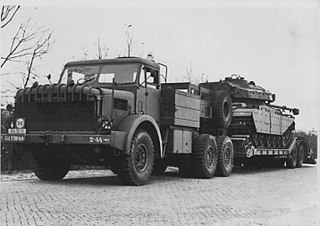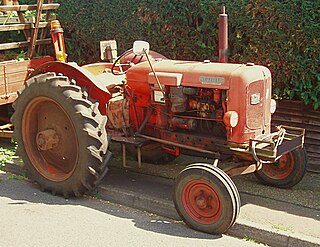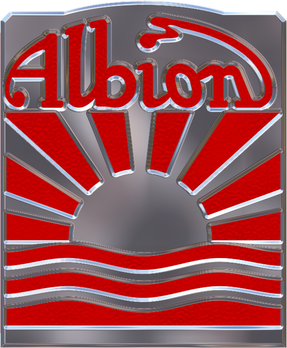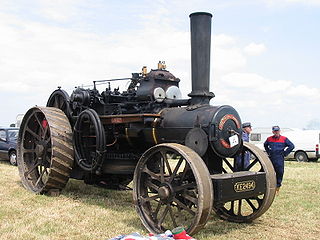
Track Marshall was a crawler tractor, that had its origins in the merger of the Fowler and Marshall companies shortly after WW2.

Track Marshall was a crawler tractor, that had its origins in the merger of the Fowler and Marshall companies shortly after WW2.
The Track Marshall came about due to the takeover of John Fowler and Company (Leeds) Ltd by Marshall, Sons & Co. in 1947 - Marshall was itself owned by Thomas W. Ward Ltd (since 1935). Marshall had been making single-cylinder diesel wheeled tractors since 1930. Fowler on the other hand had been engaged in making tracked vehicles, especially during WW2. When the two companies' activities were merged it was decided that the Fowler company would manufacture a tracked version of the Field Marshall wheeled tractor. The new Fowler product was announced in early 1948 as the 'Fowler Marshall Diesel Crawler Tractor Mark V.F.'. [1] Fowler and Marshall further developed the tracked crawler and in 1951 introduced the Fowler Challenger Mk 1 with a Marshall ED5 twin cylinder 2-stroke diesel engine. Then in 1956 they started selling their new model, the Track-Marshall, which was a crawler fitted with a Perkins L4 four cylinder diesel of 48hp. Also new was the Fowler Challenger Mk 2 with a Leyland six-cylinder 60hp diesel engine. [2]
Demonstrated in 1955, and for sale in 1956 the first Track Marshall tracked tractor model was fitted with a Perkins L4 four cylinder diesel of 48hp. Fowler also produced the Challenger range of tracked tractors at the same time.
Track Marshall models were produced with increasing power over the years, and then when the business was sold to British Leyland in 1972, the models were continued branded as Aveling-Marshall.

Field-Marshall was a brand of farm tractor which was manufactured by Marshall, Sons & Co. of Gainsborough, Lincolnshire in the United Kingdom.
Coventry Victor was a British motorcycle and car manufacturer. Originally Morton & Weaver, a proprietary engine manufacturer in Hillfields, Coventry, founded in 1904, the company changed its name to Coventry Victor Motors in 1911. The company closed in 1971.

The International Harvester Company was an American manufacturer of agricultural and construction equipment, automobiles, commercial trucks, lawn and garden products, household equipment, and more. It was formed from the 1902 merger of McCormick Harvesting Machine Company and Deering Harvester Company and three smaller manufacturers: Milwaukee; Plano; and Warder, Bushnell, and Glessner. Its brands included McCormick, Deering, and later McCormick-Deering, as well as International. Along with the Farmall and Cub Cadet tractors, International was also known for the Scout and Travelall vehicle nameplates. In the 1980s all divisions were sold off except for International Trucks, which changed its parent company name to Navistar International.

Associated Equipment Company (AEC) was a British vehicle manufacturer that built buses, motorcoaches and trucks from 1912 until 1979. The name Associated Equipment Company was hardly ever used; instead it traded under the AEC and ACLO brands.

Marshall, Sons & Co. was a British agricultural machinery manufacturer founded in 1848. The company was based in the Britannia Iron Works, Gainsborough, Lincolnshire. Early production was of steam engines and agricultural machinery. Later production included diesel tractors such as the Field Marshall, Track Marshall and former Leyland wheeled tractors.

The Ferguson TE20 is an agricultural tractor designed by Harry Ferguson. By far his most successful design, it was manufactured from 1946 until 1956, and was commonly known as the Little Grey Fergie. It marked a major advance in tractor design, distinguished by lightweight, small size, manoeuvrability and versatility. The TE20 popularised Harry Ferguson's invention of the hydraulic three-point hitch system around the world, and the system quickly became an international standard for tractors of all makes and sizes that has remained to this day. The tractor played a large part in introducing widespread mechanised agriculture. In many parts of the world the TE20 was the first tractor to be affordable to the average farmer and was small and light enough to replace the draft horse and manual labour. Many TE20s remain in regular use in farming and other work and the model is also a popular collector's item for enthusiasts today.

The Mighty Antar was a heavy-duty 6×4 tractor unit built by Thornycroft from the late 1940s onwards. For some decades it was the standard tank transporter of the British Army and was also used by other nations. It was powered by a shortened V8 land version of the V12 Meteor engine, derived from the Merlin and modified to run on diesel, known as the Rolls-Royce Meteorite.

Seddon Atkinson Vehicles Limited, a manufacturer of large goods vehicles based in Oldham, Greater Manchester, England, was formed after the acquisition in 1970 of Atkinson Vehicles Limited of Preston by Seddon Diesel Vehicles Limited of Oldham. In 1974, the firm was acquired by International Harvester, which sold it in March 1984 to the Spanish group Enasa which made it a subsidiary of Pegaso. In 1990, it became part of Iveco which used the brand for various types of specialised vehicles in the United Kingdom. The range of models produced included EuroMover, Pacer and Strato, which are aimed at refuse collection, recycling and construction operators.

The Nuffield Universal was a tractor produced from 1948 by the Agricultural Division of Morris Motors, later a subsidiary of The British Motor Corporation Limited. When William Morris the founder of Morris Motors was honoured with a title and elevated to the peerage he chose the name of his Nuffield, Oxfordshire village. When in 1948 the Morris Motors Agricultural Division launched its tractor range, the name Nuffield was chosen to be the brand name for the company's agricultural products. The design was similar to the new David Brown built tractors as the designer Dr. Merit had also worked on the design of the David Brown 50D before moving to Nuffield. Nuffield were part of the amalgamations that created British Leyland in 1968, becoming part of Leyland Tractors.

Albion Motors was a Scottish automobile and commercial vehicle manufacturer.
Scammell Lorries Limited was a British manufacturer of trucks, particularly specialist and military off-highway vehicles, between 1921 and 1988. From 1955 Scammell was part of Leyland Motors.
Aveling-Barford was a large engineering company making road rollers, motorgraders, front loaders, site dumpers, dump trucks and articulated dump trucks in Grantham, England. In its time, it was an internationally known company.


The Land Rover Series I, II, and III, or simply the Land-Rover are compact British off-road vehicles, produced by the Rover Company since 1948, and later by British Leyland. Though inspired by the World War II jeep, the Land Rover immediately distinguished itself from all other cars. From launch, it was the first mass-produced civilian four-wheel drive car with doors on it, and an available hard roof. Contrary to conventional car and truck chassis, it used a sturdier fully box-welded frame. Furthermore, due to post-war steel shortage, and aluminium surplus, Land Rovers received non-rusting aluminium alloy bodies, favouring their longevity. In 1992, Land Rover claimed that 70% of all the vehicles they had built were still in use.
The Rolls-RoyceC range was a series of in-line 4, 6 and 8 cylinder diesel engines used in small railway locomotives, construction vehicles, marine and similar applications. They were manufactured by the Rolls-Royce Oil Engine Division headed by W. A. Robotham to 1963, initially at Derby and later at Shrewsbury, from the 1950s through to 1970s.
W.H. Dorman & Co was a company formed by William Henry Dorman in 1870 making cutting tools for the footwear industry. It diversified into other tools including grinders, and in 1903 into internal combustion engines. This was to be its main product up to the point where it was taken over by the English Electric Company in 1961, though the Dorman name continued as a diesel engine trademark until 1995. William Henry Dorman retired in 1911, and died in 1926.

Lamborghini Trattori is an Italian agricultural machinery manufacturer. The company designs and builds tractors. It was founded in 1948 in Cento, Italy by Ferruccio Lamborghini, who later went on to establish Automobili Lamborghini. In 1963, it became part of SAME.
Bubba Trattori is an Italian manufacturer of tractors and other agricultural equipment.
The Turner Manufacturing Company was an engineering company based in Wolverhampton, England. Among their products were steam and petrol cars, small boat engines, the Turner winch, a range of diesel engines made in the 1940s and 1950s, the Yeoman of England agricultural tractor, and truck transmissions - the latter leading to their eventual takeover.
The Mercury Truck & Tractor Company was based in Gloucester, England and manufactured small industrial vehicles for use primarily within factories carrying loads or hauling trailers, road vehicles for moving rail trucks in yards, and vehicles for airfields for towing munitions trolleys or baggage trolleys. In later years they produced increasingly powerful aircraft tugs.